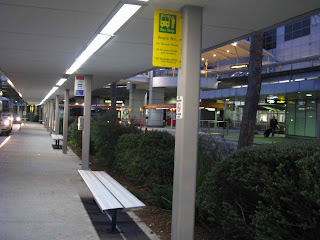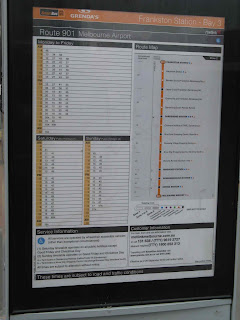Pedestrian strategy and who gets what
Almost unremarked in the mainstream media was the launch of the State Government’s Pedestrian Access Strategy earlier this month. It follows the Cycling strategy released previously.

Rather than explore the strategy, this post will look at how pedestrian resources have been allocated and hence reveal some of the choices and priorities of State Government policy makers to date.
Differing fortunes
Walking and public transport have had different fortunes in the last 30 years.
Metropolitan public transport patronage reached a low point in 1980. Until the early 2000s there were rises and falls, but an overall increase (generally in line with population but insufficient to increase modal share). 2004 – 2009 saw accelerated growth, sufficient to increase transit’s modal share. Preoccupied with rail franchising, refranchising and regional projects, the State Government tapped into this trend quite late but is now providing significant ‘catch-up’ funding for improved bus services and rail infastructure. In the last year train patronage growth has slowed and additional peak services on some lines have relieved crowding though peak punctuality remains too low for reliable connectivity with buses.
Page 18 of the Pedestrian Strategy tells a different story for walking. Its modal share for work commuting more than halved between 1976 and 2001, with only a slight recovery to 2006. This fall is similar in magnitude to the collapse in suburban rail travel during the 1960 – 1980 period.
Just like public transport battled suburbanisation, rising car ownership and limited bus service levels, walking’s enemies have been rising road traffic, poor suburb design, the decline of shopping strips, increased parental protectiveness and the trend to amalgamamated and/or private schooling. And although almost everyone walks, there has been no high-profile organised pedestrian lobby group, such as enjoyed by car drivers, cyclists and public transport users.

Pedestrian funding
If public transport infrastructure spending (and even basic maintenance) can claim to have been the poor cousin to road investment over most of this period, pedestrian access funding is positively destitute.
Page 13 and 14 detail pedestrian access funding over the last ten years. The total spent or earmarked to be spent comes to over $640 million. The distribution of this is as follows:
* $350 million over 10 years to make public transport accessible to people with disabilities. An additional $150 million will be spent on infrastructure to further this.
* 2008 Victorian Transport Plan commitment of $115 million for bicycle lanes and shared bicycle and walking paths (it is not mentioned how much of this has been spent, nor what portion would benefit pedestrians)
* $16 million for the Local Area Access Program (small scale access projects involving local government)
* $5.5 million on TravelSmart (basically marketing walking/cycling/public transport over driving)
* $3.5 million for Vicroads to improve crossings of arterial roads
All public transport trips involve some walking. The ease of reaching a transit stop and vehicle is a critical part of the travel experience, so improving pedestrian access improves the overall service to a wide range of passengers, not just those with impaired mobility. There is a long-standing aim to make our system fully accessible and each passing year sees more low floor buses and tram stops. Investment here accounts for $500 million of our $640 million, or about three-quarters of all claimed pedestrian access spending.
However walking is a transport mode in its own right and the majority of walking trips do not involve a connection to public transport. Its modal share (when measured by number of trips, not trip-kilometres) commonly exceeds that of public transport in many areas, especially for non-work trips.
The amount remaining less public transport accessibility improvements is about $140 million. The lion’s share, or $115 million, went to improvements involving cycling. It is not clear how much of this can be counted as an improvement for pedestrians.
Another 3% of the $640 million, or about $20 million, goes to small-scale access improvements for which pedestrians appear to be the main beneficiary. This includes a $16 million local access program for small-scale local government projects and $3.5 million for improving pedestrian access across major roads, which can divide communities and block safe and direct pedestrian movement.
The potential importance of local projects such as these cannot be underestimated. Most of the Melbourne in 2040 already exists today, and there are thousands of projects such as median strips, traffic calming, signal modifications, roundabout removal and cul-de-sac openings that would boost the walkability of every established suburb.
Although these projects are individually cheap, their sheer number means that $20 million (over several years) doesn’t go very far. Even a twenty fold increase (which would bring the amount involved to that nearer that invested in public transport accessibility) would still represent under 1 percent of Victorian Transport Plan funding and be more consistent with the stated aim of increasing walking’s share.
Finally there is the $5.5 million for TravelSmart funding. This is more properly attributed to several modes including public transport, cycling and even car pooling rather than purely walking. TravelSmart has delivered worthwhile projects such as local access maps (now at city Bike Share racks). However comparing TravelSmart’s allocation with pedestrian access improvements on main roads ($5.5 vs $3.5 million) appears to indicate that telling people that walking is better has a higher priority than making it so, at least on our busier roads.

Priorities
What priorities and biases do these funding patterns indicate?
Disability rights advocates such as Margaret Stevens strenuously argue that the pace of accessability improvements for public transport has been too slow. Melbourne has a particuar problem with its trams as most are older high floor units and many stops are still mid-road ‘safety zones’ that provide for poor access. Funding for accessibility improvements is a minority of total Victorian Transport Plan funding but represents a majority of state government pedestrian funding. Against this it could be considered to be a top priority.
In the middle are various paths, for both cyclists and pedestrians.
At the bottom are local pedestrian access projects, especially where they involve access across main roads.
These funding priorities indicate a welcome tendency to build (or improve) paths but a reluctance to improve access across main roads. A bad path (or none at all) is unattractive to walkers and should be fixed. But at least for the able-bodied it does not seriously reduce end-to-end access speeds (which is the only sound way to measure pedsheds) provided there is some space by the road.
In contrast poor access across main roads results in them forming barriers for much of the day, often barring people of all abilities from reaching bus stops (including some served by low-floor SmartBuses) by the most direct means. Long traffic light cycles similarly compress the ten-minute pedsheds of shopping centres, railway stations and bus stops, reducing the practicality of walking compared to driving.
A pedestrian access audit would find that addressing such pedestrian access deficits on main roads (which in some case may only require an altered traffic light cycle, zebra crossing or new median strip) represent a high priority that should receive a large proportion of project funding.
However the historical reality of funding, according to Pedestrian Strategy figures, is different; just $3.5 million out of $640 million funds went to Vicroads for this purpose.
The Pedestrian Access Strategy is what bureaucrats call a ‘high level’ document with many excellent ideas – if only they were implemented. Its ‘Making it happen’ section describes a governance and consultation process. However it does not give a funding amount nor an indicative works program (eg annual targets for new footpaths, median strips, pedestrian lights, zebra crossings, cul-de-sac joinings and roundabout removals).
Until such a substantive construction program commences, it would appear that Melbourne has a way to go until pedestrians are regarded as legitimate traffic rather than impediments to same, and that road managers can implement goals other than the maximisation of car traffic speed and throughput.




































